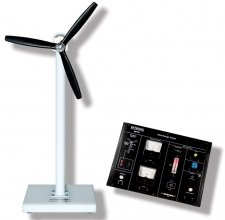-
Basic Solar Energy Trainer
ViewThe Solar Energy Trainer introduces the fundamentals of a solar cell (photovoltaic Cell) and conversion of the suns photons into electrical energy. This can be monitored with a built in voltmeter and ammeter to measure the voltage and current produced. The Trainer allows the study of the characteristics and application of solar energy and the charge of batteries using solar energy.
Experiments
- Calculation of voltage and current of solar cells
- Calculation of voltage and current of solar cells in parallel
- Study of V – I curve and power curve of solar cells to find the maximum power point (MPP) and efficiency of a solar cell
- Calculation of solar cell efficiency
- Application of solar cells in domestic use to charge a battery operated lamp, fan and radio
-
Bio Energy Trainer
ViewThe bio energy trainer is used to show the functions of renewable fuel cell technology by using Isopropyl alcohol as the biofuel and bio energy derived from biofuels such as bioethanol, biodiesel, etc. The energy generated using the BIET can be used to run applications built into the unit such as the buzzer and fan.
-
Fuel Cell Trainer
ViewThe fuel cell trainer is a modular experimental system using renewable power generation that allows the study of a working solar-hydrogen cycle from photovoltaic technology (Solar Panel). The fuel cell trainer uses the element (Hydrogen) of water as a renewable energy carrier that can power applications. The fuel cell is reversible and acts as both an electrolyses and a fuel cell and can be used to study how renewable energy can be harnessed, stored and re-used. The trainer includes hydrogen and oxygen storage tanks with a reversible fuel cell, a solar photovoltaic panel and an application board.
-
Wind Power Trainer
ViewThe Wind Power Trainer introduces the fundamentals of wind power and the conversion of kinetic energy into electrical energy through a wind turbine. This can be monitored with the built in voltmeter and ammeter to measure the voltage and current produced. Energy produced is used to power an on board fan, radio, LED lights and charge batteries.
Experiments
- Measurement of voltage and current of wind energy based DC supply with change in angle of blades
- Measurement of a voltage and current DC supply of a wind energy based supply with change in direction of wind
- Measurement of a voltage and current DC supply of a wind energy based supply with change in wind speed imposed on the blades
- The application of wind energy based DC supply for charging the Ni-Cd battery allowing the load to be used while the module is unexposed to wind
- The application of a wind energy based DC supply for providing electrical energy to domestic items such as a lamp, fan and FM receiver




